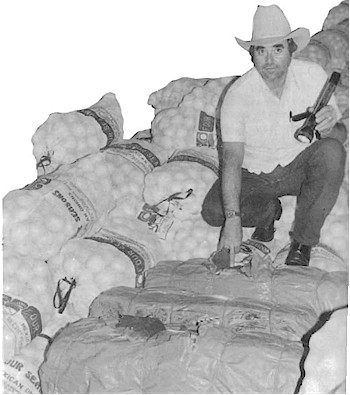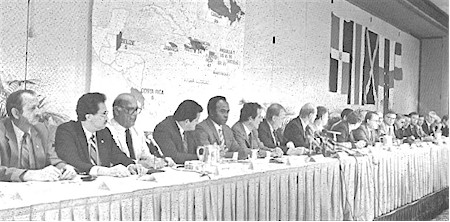Fugitive Investigative Strike Teams (FIST)
In the 1980's the U.S. Marshals Service inaugurated the use Fugitive Investigative Strike Teams, referred as FIST operations, to capture violent fugitives that were wanted by Federal and local law enforcement agencies.
The goal of a Fugitive Investigative Strike Teams operation was to locate and arrest a large number of fugitives in a particular region, within a relatively brief period, by focusing the resources of local, state, and Federal law enforcement agencies. Non-federal officers were specially deputized by the Marshals Service enabling them to cross city, county, and state boundaries with full arrest powers.

When the Attorney General transferred responsibility for the investigation of certain Federal fugitives from the Federal Bureau of Investigation to the Marshals Service in October 1979, fugitive operations began to come alive throughout the Service.
As a result, 105 Deputies were selected for advanced training as Enforcement Specialists dedicated to overseeing the investigation and apprehension of Federal fugitives within their respective Districts and nationwide.
Subsequently the Marshals Service developed the Fugitive Investigative Strike Team (FIST) concept. This method was designed to augment the resources of District fugitive squads experiencing an increased case load, and to focus efforts on areas where intelligence indicates the existence of a significant number of fugitives from justice.
Fugitive Investigative Strike Teams utilized a team of investigators which could be quickly mobilized to respond to any District in the country. Its objectives are to reduce the case backlog and apprehend as many fugitives as possible within the target District in the shortest possible time.
The effort focused on U.S. Marshals Service "Class 1" violators - escaped federal prisoners, bail jumpers, parole violators and probation violators.
Part of the unprecedented challenge and change which the Marshals Service encountered during the early 1980's was the ability to respond to the Administration's demand for a step up in law enforcement. A portion of the Service's response to this challenge was the development of the Fugitive Investigative Strike Team (FIST) concept.

The first FIST operation was designed as a pilot project to focus on fugitive felons. The objectives were to reduce case backlogs and to apprehend as many fugitives as possible within the largest District in the shortest possible time, yet remain cost effective. On October 6, 1981, Fugitive Investigative Strike Teams I began in the Southern District of Florida (Miami). The large volume of drug trafficking and violence-related crimes concentrated in that area indicated that Miami was the city most urgently in need of Fugitive Investigative Strike Teams.
After five weeks the operation concluded with the arrest of 76 fugitive felons. An analysis showed that 55 percent of the fugitives arrested had a criminal history involving narcotics. Prior arrests of these 76 fugitives totaled 491 criminal incidents, or an average of six previous crimes per arrestee.
The success of FIST I prompted the Department of Justice and the Marshals Service to continue this type of operation in another location. FIST II was conducted in Los Angeles, California from early December 1981 to early February 1982. This nine-week investigative effort resulted in the arrest of 102 fugitive felons and included the clearing of 35 state and local fugitive cases in the Los Angeles area.
Marshals Service analysis showed 28 percent of the arrestees had previously been involved in narcotics trafficking. The other arrestees had criminal records for other offenses which included homicide, bank robbery, kidnapping, assault, armed robbery, alien smuggling and counterfeiting. The combined history of these arrestees totaled 865 prior felony arrests. At the conclusion of FIST II, the Marshals Service examined the feasibility of a Fugitive Investigative Strike Teams operation involving state and local law enforcement authorities. Many fugitives sought by the Marshals Service are also sought by state and local authorities for other crimes. The success of FIST I and II was due, in a large part, to the cooperation and involvement of state and local law enforcement officers.
The operation of FIST III was conducted in the multi-judicial District New York City metropolitan area, starting April 13, 1982 and continuing for ten weeks. FIST III incorporated the active participation of the New York City Police Department.
Using an abandoned warehouse on the East River as its headquarters, Marshals and New York City Police Department investigators arrested 303 fugitive felons. Prior offenses of these arrestees totaled over 3,000.
FIST IV focused on fugitives in the Washington, D.C. area. The operation, which was conducted jointly by the United States Marshals Service and the District of Columbia Metropolitan Police Department between September 7 through November 18, 1982.
This Fugitive Investigative Strike Teams operation was also composed of 29 representatives of the Special Operations Division Warrant Squad of the Metropolitan Police and an equal number of Marshals Service investigators from around the nation. FIST IV concluded with a total of 614 actual arrests and 772 warrants cleared.
The participation of state and local governments was expanded for FIST V in mid 1983 during a ten-week operation throughout Michigan. During this FIST, combined teams of federal, state and local investigators cleared 1,156 felony warrants, 928 by actual physical arrest.
FIST VI culminated a unique effort which concentrated on arresting fugitives throughout the State of California. The conclusion of the ten-week operation, which resulted in 2,116 arrests. Of those arrested 79 percent had been involved in crimes of violence or drug offenses and a total of 2,689 cases were closed as a result of the arrests. The operation utilized the resources of more than 20 California state and local law enforcement agencies which made up half of the 120- member FIST VI group.
The conclusion of FIST VII was announced by the Attorney General on November 20, 1984 before national and international media representatives in a press conference at the Plaza Hotel in New York City. He termed FIST VII "the largest and most successful fugitive manhunt in law enforcement history." The operation was conducted throughout eight eastern states over an eight-week period and resulted in the arrest of 3,309 fugitive felons. The operation was a result of the combined efforts of 49 state and local law enforcement agencies under the coordination of the U.S. Marshals Service.
The FIST VII task force was made up of thirteen Marshals Service personnel, five agents from the Bureau of Alcohol, Tobacco and Firearms, and 107 state and local law enforcement officers from Connecticut, Delaware, Maryland, Massachusetts, New Jersey, New York, Pennsylvania and Rhode Island. The apprehended fugitives had a composite criminal history of 12,440 felonies, with a per fugitive average of nearly four known prior arrests and convictions.
Commenting on the conclusion of the record-breaking FIST VII operation, Former Marshals Service Director Stanley E. Morris said, "Fugitives are a major contribution to the high crime rate in this country, as they typically commit additional crimes in order to remain fugitives from justice. Many state and local law enforcement agencies are unable to actively seek fugitives simply due to a lack of resources.
During this Fugitive Investigative Strike Teams operation, 95 percent were arrested on state or local warrants. Through Fugitive Investigative Strike Teams operations we are bringing about an awareness of this serious problem. By combining federal, state and local law enforcement officers, a FIST team can free manpower to concentrate exclusively on the apprehension and arrest of fugitives."
As in previous operations, FIST VII utilized "scams" to apprehend a number of fugitives. These included a package-delivery scam under the identification of the "Brooklyn Bridge Delivery Service," job offers from "Prior Offenders Employment Opportunities," and one in which younger fugitives were attracted by a "Prize Offer" of free tickets to a rock concert, complete with dinner for two and the use of a limousine for the evening.
The continued overwhelming success and highly professional execution of the first seven Fugitive Investigative Strike Teams operations was obvious not only from the more than 7,000 fugitives arrested, but also from the continued record of no subjects or law enforcement officers being seriously injured or killed in any of the operations. William French Smith, former Attorney General, praised the efforts of all involved in the FIST VII operation when he stated, "This successful operation demonstrates our unwillingness to allow fugitives from justice to remain outside the system where they may, and do, prey upon innocent Americans. Fugitives must be arrested and returned to the point in the system from which they fled. Then, and only then, can justice be done."
The United States Marshals Service, 38 Florida law enforcement agencies and 12 foreign countries captured 3,816 fugitives in the eighth Fugitive Investigative Strike Teams operation in the spring of 1985.
Law enforcement personnel based in Miami, with teams set up in Pompano Beach, Tampa, Tallahassee, Orlando, and Jacksonville, nabbed 48 accused or convicted murderers, 20 kidnappers, 61 rapists, 167 robbers and 593 major narcotics traffickers. Forty-eight weapons were seized, including handguns, shotguns, rifles and machine guns.
The Caribbean command site was located in St. Thomas, U.S. Virgin Islands, with Marshals Service personnel operating in Antigua, Anguilla, Barbados, Belize, British Virgin Islands, Curaçao, Aruba, Costa Rica, Dominican Republic, Haiti, Jamaica, Martinique, and Puerto Rico.
Another element of FIST VIII that differed from past operations was the inclusion of the Services' Special Operations Group (SOG) as an operational element at the Miami site.
FIST IX included 31 state and local law enforcement agencies from Arizona, California, New Mexico, and Texas, along with the former Immigration and Naturalization Service and the former U.S Border Patrol, and the Mexican Federal Judicial Police. The FIST teams, comprised of Deputy U.S. Marshals and officers of the other agencies, operated out of eight U.S. cities and five in Mexico.
During eight weeks of operation and following months of preparation and planning, the FIST 9 teams conducted fugitive investigations from operational sites in Phoenix and Tucson, Arizona; San Diego, California; Albuquerque, New Mexico; El Paso, San Antonio, McAllen and Houston, Texas; and the Mexican cities of Tijuana, Nogales, Ciudad Juárez, Matamoras, and Mexico City.
Sting Operations
Although most of the arrests in Fugitive Investigative Strike Teams Operations were made through good, hard, traditional investigations, the strike teams also devised creative "stings" to trick some of the fugitives:

